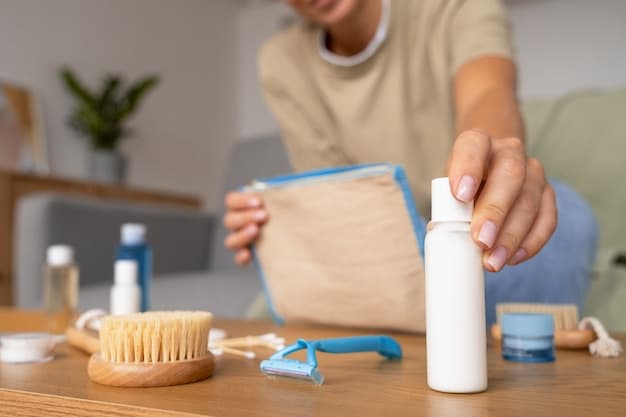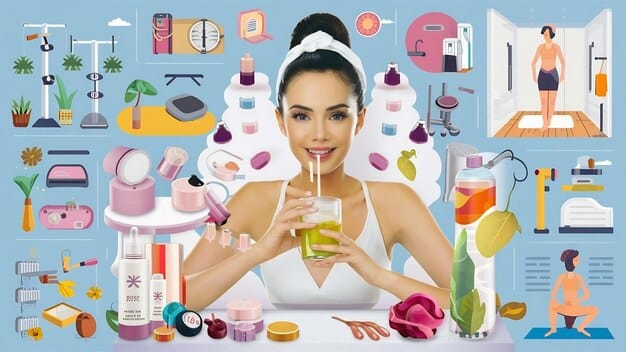Decoding Skincare Labels: A 2025 Guide to Ingredients & Formulations

Decoding skincare labels is crucial for understanding the ingredients and formulations in your skincare products, empowering you to make informed choices for healthier skin in 2025.
Embarking on a journey towards better skin often begins with understanding what exactly you’re putting on it. Decoding skincare labels: A comprehensive guide to understanding ingredients and formulations in 2025 is essential for navigating the complex world of skincare and making informed decisions.
The Importance of Decoding Skincare Labels
In the ever-evolving world of skincare, staying informed is key. Being able to decipher the often-confusing language on skincare product labels is not just a skill, but a necessity. It empowers you to choose products that truly benefit your skin.
Understanding the ingredients listed on a product is fundamental for several reasons:
- Avoiding Allergens and Irritants: If you have sensitive skin or known allergies, knowing how to read labels can help you avoid ingredients that may cause adverse reactions.
- Making Informed Decisions: Being able to identify beneficial ingredients allows you to select products targeted to your specific skin concerns, improving efficiency in your routine.
- Understanding Formulations: Not all products are created equal. Understanding how ingredients are combined gives insight into the product’s efficacy and intended use.
By the year 2025, the demand for transparency in all industries is only expected to increase. Consumers will be more inclined to seek out information and understand the products they use. Grasping the basics of skincare ingredients is already a must-have.
Key Ingredients to Look For in 2025
Skincare formulations are constantly advancing, and the ingredients considered “essential” are also changing. Staying on top of these key components is important for building an effective skincare routine.
Antioxidants
Antioxidants are vital for protecting the skin from environmental damage caused by free radicals. These molecules can accelerate aging and lead to various skin issues. Look for these antioxidants:
- Vitamin C: Brightens skin and boosts collagen production.
- Vitamin E: Hydrates skin and provides an additional layer of UV protection.
- Green Tea Extract: Calms inflammation and reduces redness.
Hydrators
Hydration is the cornerstone of healthy skin. Including hydrating ingredients into your everyday skincare is essential, whether you have oily or dry skin. These ingredients are key to achieving and maintaining a healthy skin barrier:
- Hyaluronic Acid: A humectant that draws moisture into the skin.
- Glycerin: Another humectant that helps to keep skin hydrated.
- Ceramides: Lipids that restore the skin’s natural barrier, preventing moisture loss.
Exfoliants
Exfoliating ingredients help to remove dead skin cells, revealing brighter, smoother skin. However, over-exfoliating can damage the skin barrier, so it is important to proceed with caution when introducing these products into your routine.
- AHAs (Alpha Hydroxy Acids): Glycolic and lactic acids are some examples, they smooth texture and reduce hyperpigmentation.
- BHAs (Beta Hydroxy Acids): Salicylic acid is the most used BHA, it penetrates pores to clear out excess sebum and reduce acne.
- Enzymes: Papain and bromelain offer a gentle exfoliation alternative, they are derived from fruits.
Understanding these essential ingredients is just the first step. Knowing how to decode the rest of the label empowers you to create the best possible routine.

Commonly Misunderstood Terms on Skincare Labels
Skincare labels often include terms that are misleading or require deeper understanding. Clarifying these terms ensures that you know exactly what you’re applying to your skin.
“Fragrance-Free” vs. “Unscented”
These terms aren’t interchangeable. “Fragrance-free” means that no fragrances have been added to the product. “Unscented” means that the product may still contain fragrances used to mask the original scent of the ingredients.
“Non-Comedogenic”
This term indicates that the product is formulated to not clog pores, reducing the likelihood of breakouts. However, individual reactions can still vary, and patch-testing is recommended.
“Hypoallergenic”
This term suggests that the product is less likely to cause an allergic reaction. Yet, it’s not a regulated term, meaning that the product can still cause irritation for some people.
Decoding these terms is essential, but mastering how ingredients are listed can be an advantage.
Order of Ingredients: What It Really Means
The order in which ingredients are listed on a label is not random. The FDA requires manufacturers to list ingredients in descending order by weight. This means that the ingredients listed first have a higher concentration in the formula, and those listed later have a lower concentration.
Here’s how to interpret the order of ingredients:
- Top Ingredients: The first few ingredients listed make up the bulk of the product.These are generally water, solvents, or other base ingredients.
- Active Ingredients: These typically come after the base ingredients and are present in concentrations relevant to their intended function.
- Preservatives: These are necessary to prevent bacterial growth and extend the shelf life of the product, they are generally listed towards the end of the ingredient list, as only small amounts are needed to be effective.
How to Interpret Ingredient Lists
Understanding the order of ingredients on the label is crucial to making the right purchase. If a product is advertising a high concentration of a key ingredient, but is listed at the end, it could indicate that it is only present in trace amounts.
By being aware of ingredient order, you can assess whether the product’s claims align with its composition.
Spotting Harmful Ingredients to Avoid
While many skincare ingredients are beneficial, some can be harmful to your skin or even your overall health. Knowing which ingredients to avoid is just as important as knowing which ones to look for.
- Parabens: Used as preservatives but linked to endocrine disruption. Commonly found in many personal care products, they might be listed as methylparaben, ethylparaben, propylparaben, butylparaben, and isobutylparaben.
- Sulfates: Harsh cleansing agents (like SLS and SLES) that can strip the skin of its natural oils, causing irritation and dryness.
- Phthalates: These are used to make plastics more flexible and are found in a variety of consumer products. They are linked to endocrine disruption and reproductive toxicity. Common phthalates include dibutyl phthalate (DBP), dimethyl phthalate (DMP), and diethyl phthalate (DEP)
Reading and understanding skincare labels helps to reduce exposure to harmful chemicals, protect your skin, and make well educated decisions.

Clean Beauty and Sustainable Formulations in 2025
The demand for clean and sustainable beauty products continues to grow in 2025. Consumers are more aware of the environmental impact of their skincare choices and are seeking products that are both safe and eco-friendly.
What Is Clean Beauty?
Clean beauty refers to products that are formulated without ingredients considered harmful to human health or the environment. These typically exclude parabens, sulfates, phthalates, synthetic fragrances, and other potentially toxic chemicals.
Sustainable Formulations
Sustainable formulations focus on using ingredients that are ethically sourced and produced with minimal environmental impact. This includes using renewable resources, reducing waste, and implementing eco-friendly packaging.
Benefits of Sustainable Products
Sustainable products are not only better for the environment but can also be gentler on your skin. By choosing products with natural and sustainably sourced ingredients, you can reduce exposure to harsh chemicals and support responsible beauty practices.
The key to making informed decisions is understanding what’s on the label. Staying informed about clean beauty and sustainable formulations ensures that your skincare choices align with your health and environmental values.
By understanding skincare labels, you empower yourself to make informed choices that benefit your skin and align with your personal values. Stay informed, ask questions, and embrace the journey to healthier, radiant skin.
| Key Point | Brief Description |
|---|---|
| 🔎 Ingredient Order | Ingredients are listed from highest to lowest concentration. |
| 🌱 Clean Beauty | Focuses on products without harmful ingredients, safe for health and environment. |
| 🚫 Harmful Ingredients | Avoid parabens, sulfates, and phthalates due to potential health risks. |
| 💧 Hydrators | Look for hyaluronic acid and glycerin for essential skin hydration. |
Frequently Asked Questions
▼
Understanding skincare labels allows you to make informed decisions about the products you use. It also helps you avoid harmful ingredients and choose products that align with your skin type and concerns.
▼
“Non-comedogenic” means the product is formulated not to clog pores, decreasing the risk of breakouts. However, individual reactions can vary, and patch-testing is recommended.
▼
Look for ingredients such as parabens, sulfates, and phthalates. These chemicals have been linked to health risks and can cause skin irritation. Researching ingredients can also help avoid certain chemicals.
▼
No, “fragrance-free” means that no fragrances have been added, while “unscented” means that the product may contain masking fragrances to cover the smell of ingredients. Always check the ingredients.
▼
Clean beauty refers to products formulated without harmful or questionable ingredients. It is important because it prioritizes your health and the environment by reducing exposure to toxic chemicals.
Conclusion
In conclusion, decoding skincare labels: A comprehensive guide to understanding ingredients and formulations in 2025 provides valuable tools for making informed choices about your skincare routine. By understanding ingredient lists, avoiding harmful substances, and embracing clean and sustainable products, you can achieve healthier, more radiant skin while supporting a more ethical and environmentally responsible beauty industry.





